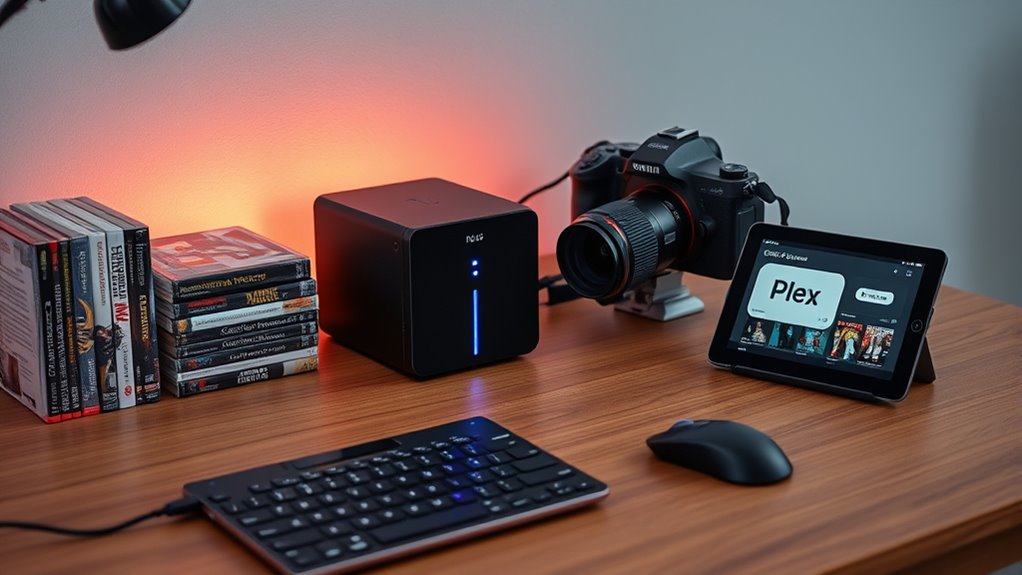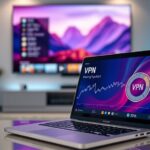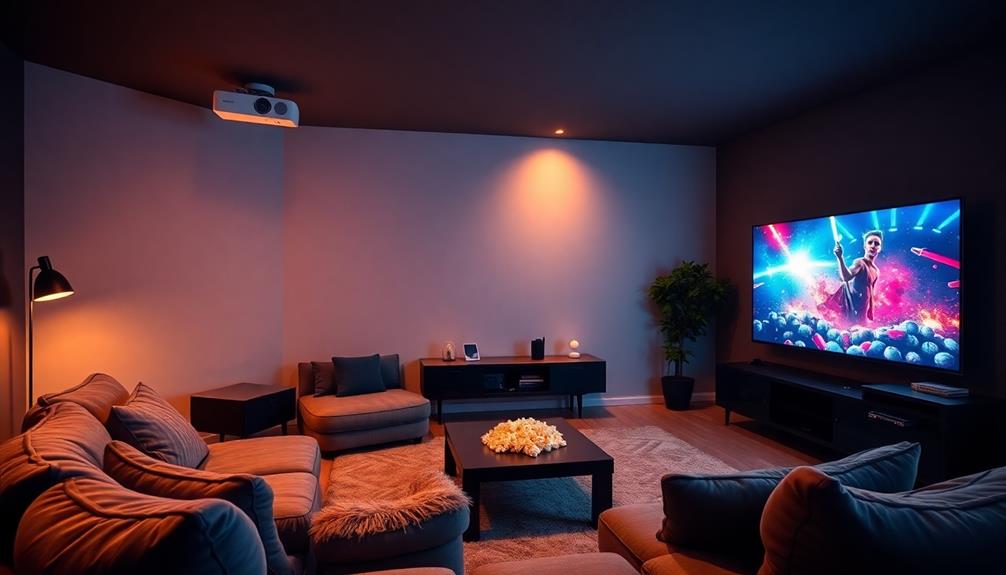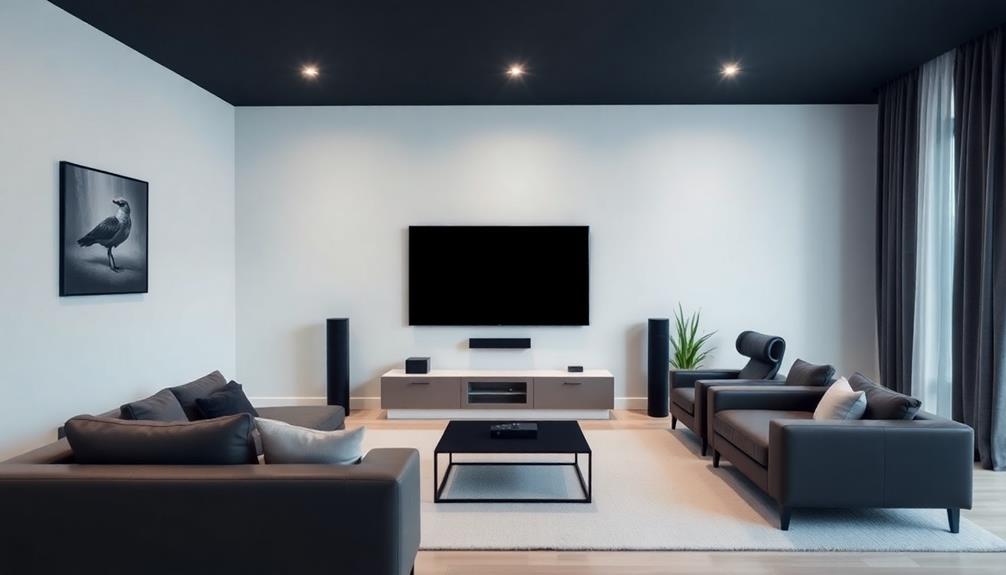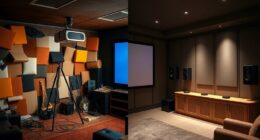To set up a home media server for your movie collection, start by choosing your hardware—like repurposing an old PC, buying a NAS, or building a dedicated server—based on your storage needs and skills. Install user-friendly software like Plex or Jellyfin and organize your library into clear folders. Make certain your network is fast enough for smooth streaming and configure remote access. Staying current with updates guarantees peak performance. Keep exploring to learn how each step enhances your media experience.
Key Takeaways
- Choose suitable hardware such as a NAS, old PC, or custom server based on storage needs and technical comfort.
- Install media server software like Plex, Jellyfin, or Emby and organize your media files into clearly labeled folders.
- Configure network and server settings, including remote access and transcoding options, for optimal streaming performance.
- Connect devices like smart TVs, phones, and tablets with compatible media apps for seamless content playback.
- Regularly update your media library and server software to maintain security, functionality, and easy access to your movies.
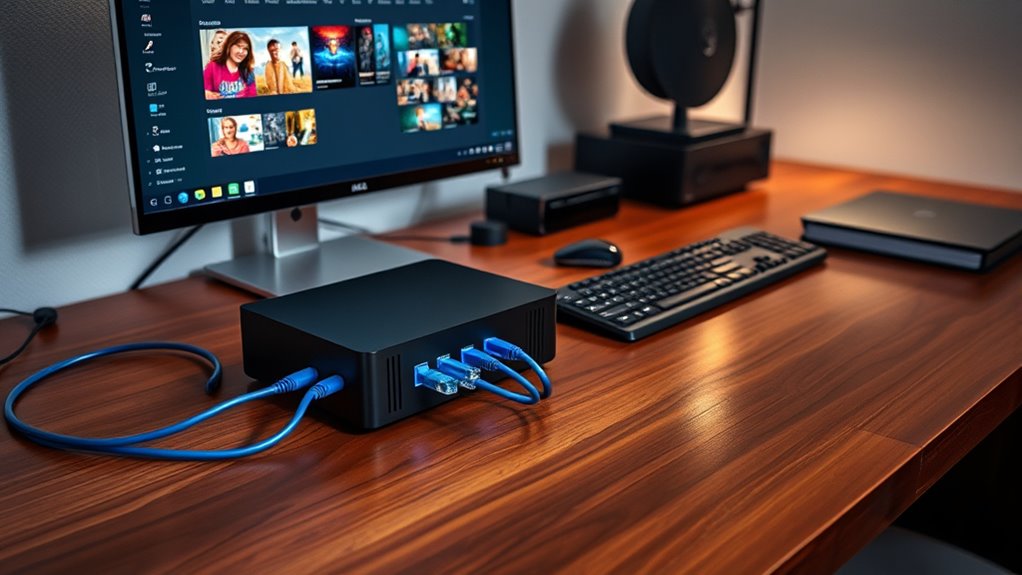
Setting up a home media server is an excellent way to centralize your digital content and enjoy it seamlessly across all your devices. Whether you have a large movie collection or a growing library of music and photos, a dedicated server allows you to access everything from your TV, laptop, tablet, or smartphone without juggling multiple drives or relying on external hard drives. The first step is choosing the right hardware. You can repurpose an old PC, buy a dedicated Network Attached Storage (NAS) device, or build a custom server. Your choice depends on how much storage you need, your budget, and how much technical setup you’re comfortable with. A basic NAS like Synology or QNAP offers a user-friendly experience with built-in media server options, while repurposing an old PC gives you flexibility but requires more setup and maintenance.
Centralize your digital media with a custom server or NAS for seamless access across devices.
Next, you’ll want to select a media server software that fits your needs. Plex is one of the most popular options because of its intuitive interface, compatibility across devices, and robust features. It automatically organizes your media, adds cover art, and provides easy access to your content from anywhere. Alternatively, you can go for Jellyfin or Emby if you prefer open-source or more customizable solutions. Once you’ve picked your software, install it onto your server. This process usually involves downloading the application, following the setup wizard, and pointing it to your media folders. Make sure to organize your movies into clearly labeled folders for easy navigation.
After installing your media server software, you need to add your media library. For movies, create a main folder named “Movies” and organize subfolders by genre or alphabetically. For TV shows, do the same in a “TV Shows” folder, ensuring each show has its own directory with individual episodes labeled properly. This organization helps your media server scan and catalog your collection accurately. To optimize your media server’s performance, it’s important to consider factors like network speed and hardware resources, which can impact streaming quality and overall user experience. Once your media is added, customize your settings for remote access, transcoding quality, and user permissions if you share with others. Enabling remote access allows you to stream your movies on the go, while adjusting transcoding settings ensures smooth playback on various devices.
Lastly, connect your devices to the server. Install the media server app or compatible client apps on your smart TV, phone, or tablet. Log in with your credentials, and your media library should appear ready to browse and stream. With everything in place, you’ll enjoy a clean, centralized media hub that makes accessing your movie collection effortless. Regularly update your media library by adding new titles and maintaining your server’s software. This setup not only keeps your digital content organized but also elevates your entertainment experience, giving you instant access to your favorite movies whenever you want.
Frequently Asked Questions
How Much Storage Do I Need for My Movie Collection?
When figuring out how much storage you need for your movie collection, consider the number of movies you want to keep and their average file size. If you have high-definition movies, each could take 4-8 GB, while 4K movies can be 20-100 GB or more. Estimate your collection size and add some extra space for growth. A good rule of thumb is to have at least double your current library for future additions.
What Internet Speed Is Required for Smooth Streaming?
To stream smoothly, you’ll want a fast internet connection. Aim for at least 10 Mbps for HD movies, but 25 Mbps or higher is better for 4K content. If multiple devices stream simultaneously, consider a higher speed to prevent buffering. Your upload speed also matters if you’re sharing or hosting content. Overall, a stable, high-speed connection guarantees you enjoy your movies without interruptions.
Can I Access My Media Server Remotely?
Ever wondered if you can access your media server from anywhere? The answer is yes, but it’s not automatic. You’ll need to set up remote access through your server’s settings, configure your network, and make certain your router supports port forwarding. Once done, you’ll be able to stream your movies on the go, anytime, anywhere. Just follow the steps carefully, and your media library becomes truly portable.
Which Operating System Is Best for a Media Server?
When choosing the best operating system for your media server, consider your familiarity and needs. If you want user-friendly setup and wide app support, go with Windows or macOS. For more control and customization, Linux distributions like Ubuntu or CentOS are great options. If you prefer stability and low resource use, FreeNAS or TrueNAS are excellent. Pick what suits your tech skills and future scalability best for a seamless experience.
How Do I Back up My Media Library?
Think of your media library as a treasure chest—you wouldn’t want it lost forever. To back it up, you should copy your files to an external drive or cloud storage regularly. Use backup software or built-in OS tools to automate the process. Keep multiple copies in different locations if possible. This way, your collection stays safe, no matter what surprises life throws your way.
Conclusion
Now that you’ve got your home media server up and running, you’re all set to enjoy your movie collection anytime, anywhere. Just remember, Rome wasn’t built in a day, so take your time to fine-tune your setup. With a little patience and some tinkering, you’ll have a seamless entertainment hub that’s worth its weight in gold. So go ahead, sit back, press play, and let your media server do the heavy lifting.
